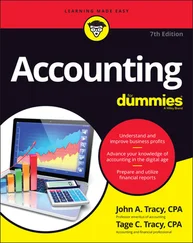Kenneth W. Boyd - Cost Accounting For Dummies
Здесь есть возможность читать онлайн «Kenneth W. Boyd - Cost Accounting For Dummies» — ознакомительный отрывок электронной книги совершенно бесплатно, а после прочтения отрывка купить полную версию. В некоторых случаях можно слушать аудио, скачать через торрент в формате fb2 и присутствует краткое содержание. Жанр: unrecognised, на английском языке. Описание произведения, (предисловие) а так же отзывы посетителей доступны на портале библиотеки ЛибКат.
- Название:Cost Accounting For Dummies
- Автор:
- Жанр:
- Год:неизвестен
- ISBN:нет данных
- Рейтинг книги:4 / 5. Голосов: 1
-
Избранное:Добавить в избранное
- Отзывы:
-
Ваша оценка:
- 80
- 1
- 2
- 3
- 4
- 5
Cost Accounting For Dummies: краткое содержание, описание и аннотация
Предлагаем к чтению аннотацию, описание, краткое содержание или предисловие (зависит от того, что написал сам автор книги «Cost Accounting For Dummies»). Если вы не нашли необходимую информацию о книге — напишите в комментариях, мы постараемся отыскать её.
Cost Accounting For Dummies
Cost Accounting For Dummies
Cost Accounting For Dummies — читать онлайн ознакомительный отрывок
Ниже представлен текст книги, разбитый по страницам. Система сохранения места последней прочитанной страницы, позволяет с удобством читать онлайн бесплатно книгу «Cost Accounting For Dummies», без необходимости каждый раз заново искать на чём Вы остановились. Поставьте закладку, и сможете в любой момент перейти на страницу, на которой закончили чтение.
Интервал:
Закладка:
That number is the unit sales needed to reach your goal. Say your application sells for $40 per unit, and you have variable costs of $20 per unit. Fixed costs amount to $1,000. Plug those numbers into the formula:
Profit ($0) = sales – variable costs – fixed costs
Profit ($0) = (units × $40) – (units × $20) – $1,000
Profit ($0) = units × ($40 – $20) – $1,000
Profit ($0) = units × $20 – $1,000
To finish this little piece of algebra, add $1,000 to both sides of the equation. Then divide both sides by 20: X = 50, or 50 units.
$1,000 = units × $20
$1,000 / $20 = units
50 = units
You need to sell 50 units at $40 per unit. If you don’t think you can sell at least 50 units of software, don’t get on the plane for the trade show.
Financial losses: The crash of your cash
When your unit sales are less than breakeven, you’re operating at a loss. And that could affect the cash you need to operate each month. You likely will need cash to pay expenses (such as rent, utilities, and salaries) before you collect cash from sales.
Every time you incur a loss, it’s likely your available cash balance will decline. Generally, losses reduce your cash balance; conversely, profits increase them. Assume your loss for the month is $1,000. After you collect cash on all your sales and pay cash for all the bills, your ending cash balance will be $1,000 lower than where you started.
Losses are the curse of business. After all, the business exists to generate profits. Maybe the only good news about a loss is that it gets you analyzing and fixing problems.
Contribution margin: Covering fixed costs
Variable costs probably won’t keep you up at night. It’s the fixed costs that may cause insomnia, whether you’re talking about trade-show cost, the monthly rent, or salaries you need to pay your employees each month.
You focus on covering fixed costs using the contribution margin (that is, sales less variable costs):
Contribution margin = sales – variable costs
 Contribution margin is the money derived from sales after you have covered variable costs, which is used to cover fixed costs and keep for your profit:
Contribution margin is the money derived from sales after you have covered variable costs, which is used to cover fixed costs and keep for your profit:
Profit = contribution margin – fixed costs
You also can use contribution margin to compute your breakeven point in terms of units. Remember that the breakeven point is the sales needed to cover all your costs and to create $0 profit. Consider this formula:
Breakeven point in units = Fixed costs ÷ contribution margin per unit
If you sell a software application for $40, and variable costs are $20 (which just happens to be the same as in the trade-show example), each unit has a contribution margin of $20. If you have $1,000 in fixed costs, the formula looks like this:
Breakeven point in units = $1,000 ÷ $20
Breakeven point in units = 50
If you sell 50 units, you’ve covered your fixed costs. Any sales over 50 units are all gravy and put you in Profit Land.
Lowering the breakeven point to reach profitability sooner
The lower the breakeven point, the easier it is to achieve your sales goal. It takes less effort to break even if you can lower the number of units you need to sell. Would you rather have to sell 100 units or 500 units just to break even? There’s a big difference in time, effort, and financial risk between 100 and 500 units. Think of less effort as taking less risk.
You reduce your breakeven point by changing any one of its components, if you can (and that’s sometimes a big if) . Here are some techniques, using the well-worn software application as an example.
If you can change the costs or sales, you can reduce your breakeven point. To do so, make some changes to the earlier formula:
Increasing the sale price to $45 per unit:Contribution margin per unit = $45 – $20Contribution margin per unit = $25Breakeven point in units = $1,000 ÷ $25Breakeven point in units = 40
Reducing the variable cost to $15 per unit:Contribution margin per unit = $40 – $15Contribution margin per unit = $25Breakeven point in units = $1,000 ÷ $25Breakeven point in units = 40
Reducing the fixed cost to $800 per unit:Contribution margin per unit = $40 – $20Contribution margin per unit = $20Breakeven point in units = $800 ÷ $20Breakeven point in units = 40
In each case, you lowered the breakeven point in units to 40 units instead of 50. The result? It takes less selling effort — and requires less financial risk.
Target net income: Setting the profit goal
Target net income is the profit goal you set. (I use net income and profit to mean the same thing.)
You compute target net income by plugging the figure into the breakeven formula — with one change. The profit changes from $0 to the target net income amount. Here’s the new formula:
Target net income = sales – variable costs – fixed costs
If you’re going to take that trip to the trade show, how much profit would make your trip worthwhile? How much profit could you produce if you decided not to go? Maybe that’s how you should answer the question. Assume your profit goal/target net income here is $2,000.
Using the original information for sales, variable costs, and fixed costs, you can compute the sales you need to reach target net income:
Target net income = sales – variable costs – fixed costs$2,000 = $40 × (units) – $20 × (units) – $1,000$3,000 = $20 × units)
150 = $3,000 ÷ $20
You’ll meet target net income by selling 150 units.
 You need to sell 100 more units (150 units – 50 units) to increase your profit from breakeven to $2,000. You can think about your target net income in units or dollars.
You need to sell 100 more units (150 units – 50 units) to increase your profit from breakeven to $2,000. You can think about your target net income in units or dollars.
If you attend the trade show for three days, you need to average 50 sales per day to sell 150 units. If your booth is open for ten hours a day, you need to sell an average of five units per hour. Determine whether that’s reasonable. Is there enough interest in your product to reach that level of sales? That’s the real purpose of thinking through target net income.
Lower profits and margin of safety
The margin of safety is a cushion. If things don’t go as planned — if sales are lower than your budget — you need to know how low your total sales can go before you hit the breakeven point. The word margin, in this case, refers to the amount (in dollars or units) above the breakeven point.
Consider this example: You’re getting ready to book your tickets for the trade show. You computed a breakeven point of 50 units. To reach your target net income, you need to sell 150 units. Target net income uses your budgeted sales level. The difference between your budgeted level of sales (150 units) and your breakeven sales (50 units) is your margin of safety.
If actual sales were 30 units below your budget, your units sold would be 120 (150 – 30). You’re still way above your breakeven point of 50 units. The question always is if you don’t budget correctly, how far off can you be before your unit sales are below breakeven?
Contribution margin versus gross margin
Contribution margin represents the amount of money you have left after variable costs to cover fixed costs and keep for your profit. Gross margin explains how much of your sales proceeds are left after paying cost of sales.
Читать дальшеИнтервал:
Закладка:
Похожие книги на «Cost Accounting For Dummies»
Представляем Вашему вниманию похожие книги на «Cost Accounting For Dummies» списком для выбора. Мы отобрали схожую по названию и смыслу литературу в надежде предоставить читателям больше вариантов отыскать новые, интересные, ещё непрочитанные произведения.
Обсуждение, отзывы о книге «Cost Accounting For Dummies» и просто собственные мнения читателей. Оставьте ваши комментарии, напишите, что Вы думаете о произведении, его смысле или главных героях. Укажите что конкретно понравилось, а что нет, и почему Вы так считаете.












